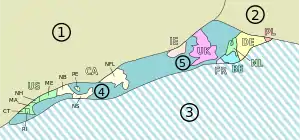| Klerf Formation | |
|---|---|
| Stratigraphic range: Emsian ~ | |
| Type | Geological formation |
| Sub-units | Reifferscheid Mb. Altenberg Mb. Unterpreth Mb. |
| Underlies | Heisdorf Formation |
| Overlies | Schleiden Formation |
| Thickness | 1,300 m (4,300 ft) |
| Lithology | |
| Primary | Siltstone, shale |
| Other | Sandstone |
| Location | |
| Location | Eifel |
| Coordinates | 50°14′48″N 06°27′21″W / 50.24667°N 6.45583°W |
| Region | Rhineland-Palatinate |
| Country | |
| Type section | |
| Named by | Richter |
| Location | Willwerath near Prüm |
| Year defined | 1919 |
| Coordinates | 50°14′48″N 06°27′21″W / 50.24667°N 6.45583°W |
| Approximate paleocoordinates | 27°06′S 9°42′E / 27.1°S 09.7°E |
| Region | Eifel |
| Country | |
 Avalonia with the Proto-Tethys Ocean (3) | |
The Klerf Formation is an Early Devonian (Emsian) formation that includes a Lagerstätte in the Northern Eifel hills, at Willwerath near Prüm, Rhineland-Palatinate, Germany. In it Jaekelopterus rhenaniae, a giant eurypterid was discovered. The Klerf Formation, comprising greenish and reddish shales, siltstones and sandstones, was first described in 1919 by Rudolf Richter (1881-1957) and reaches a maximum thickness of about 1,300 metres (4,300 ft).[1] It is part of Alken quarry along with Nellenköpfchen Formation.[2]
Depositional environment
The siltstone and sandstone formation was deposited in an estuarine to deltaic environment.[3] This was located on the edge of Avalonia bordering the Proto-Tethys Ocean.
Fossil content

Apart from the largest arthropod, Jaekelopterus rhenaniae, found in the formation, it also preserved other eurypterids (Adelophthalmus sievertsi, Parahughmilleria hefteri, Rhenopterus diensti, Pruemopterus salgadoi, Erieopterus sp.),[4] possible xiphosuran (Willwerathia),[5] terrestrial arachnids (Devonotarbus hombachensis, Xenarachne willwerathensis),[6][7] some fish, bryozoa, brachiopod and ostracod remains,[1] Mutationella indet. and flora.[8]
See also
References
- 1 2 Lithostratigraphische Einheiten Deutschlands: Klerf Formation
- ↑ Poschmann, Markus; Braddy, Simon J. (2010). "Eurypterid trackways from Early Devonian tidal facies of Alken an der Mosel (Rheinisches Schiefergebirge, Germany)". Palaeobiodiversity and Palaeoenvironments. 90 (2): 111–124. doi:10.1007/s12549-010-0024-2. ISSN 1867-1594.
- ↑ Willwerath at Fossilworks.org
- ↑ Poschmann, Markus J. (2021-03-01). "A new sea scorpion (Arthropoda, Eurypterida) from the Early Devonian of Willwerath (Rhineland-Palatinate, SW Germany)". PalZ. 95 (1): 17–26. doi:10.1007/s12542-020-00519-6. ISSN 1867-6812.
- ↑ Anderson, Lyall I.; Poschmann, Markus; Brauckmann, Carsten (1998). "On the Emsian (Lower Devonian) arthropods of the Rhenish Slate Mountains: 2. The synziphosurine Willwerathia". Paläontologische Zeitschrift. 72 (3–4): 325–336. doi:10.1007/BF02988363. ISSN 0031-0220. S2CID 128464147.
- ↑ Dunlop, Jason A.; Poschmann, Markus (1997-09-01). "On the Emsian (Lower Devonian) arthropods of the Rhenish Schiefergebirge: 1.Xenarachne, an enigmatic arachnid from Willwerath, Germany". Paläontologische Zeitschrift. 71 (3): 231–236. doi:10.1007/BF02988492.
- ↑ Poschmann, Markus; Anderson, Lyall I.; Dunlop, Jason A. (2005). "Chelicerate Arthropods, including the Oldest Phalangiotarbid Arachnid, from the Early Devonian (Siegenian) of the Rhenish Massif, Germany". Journal of Paleontology. 79 (1): 110–124. ISSN 0022-3360.
- ↑ Klerf Formation at Fossilworks.org